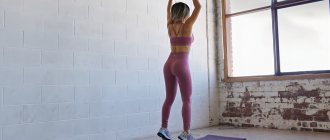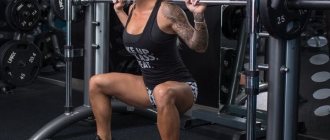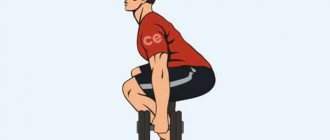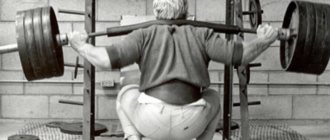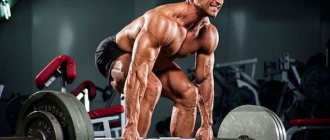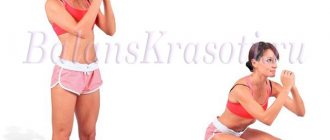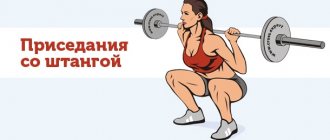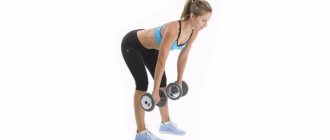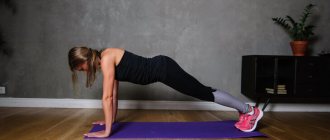Correct squats at home are included in almost any set of physical activities; they are one of the effective basic exercises that give noticeable and quick results. With its help, a beautiful hip line and expressive buttocks are formed, excess fat is removed from the lower body, and a lot of calories are burned. Additionally, performing at a fast pace speeds up the heart rate, which gives a significant cardio load. But how to squat correctly? How to do this exercise at home without a trainer?
The “Health” section is your detailed guide to healthy lifestyle issues. Training, nutrition, amateur sports - we have only the most important and useful information that will help you become better every day. Subscribe to our telegram channel to be the first to receive the latest articles.
Benefits of squats
Squats have a number of important benefits:
- slimness and fit of the lower body;
- stimulation of the production of growth hormone, due to which muscle mass quickly increases and relief is formed;
- strengthens the back muscles;
- posture improves;
- hip joints become flexible;
- lymph and blood flow accelerates;
- acceleration of metabolic processes;
- help strengthen the core and abdominal muscles;
- development of speed and strength.
Doing squats has a positive effect on endurance and develops proper balance and coordination of movements. All positive properties are achieved provided that the exercise is performed correctly. If the squatting technique is violated, the effectiveness significantly decreases.
Now let's talk about squats
As I already said, this exercise consists of two movements: extensions in the hip and knee joints. The main role in this movement is played, oddly enough, not by the quadriceps, but by the gluteus maximus muscle. It not only extends the hip joint, but also helps the quadriceps to extend the knee. Let's see how this happens.
Imagine the rectus femoris muscle as a piece of inextensible rope attached to the pelvic and tibia bones. When the hip joint extends, the load, while remaining tense, transfers force to the lower leg, helping the single-joint muscles: lateral, medial and intermediate to straighten the knee joint. The task of the rectus femoris muscle is to remain tense and transmit the force created by the gluteus maximus, which extends the hip joint. In this case, the force generated in it is somewhat less than in single-joint mice. By the way, the efforts in all four heads of the quadriceps will be equal when extending the legs in the simulator.
The load on the biarticular muscles of the back of the thigh is less than on the gluteal. Their length remains almost unchanged. They should not contract significantly, as this will interfere with the extension of the knee joint. Apparently, their role is limited to joint stabilization.
Types of squats
Once you have mastered the technique, you can make the workout more complex or varied in order to work the largest number of muscles in one session. The most common type of squats after the classic one is the plie.
How to squat “plie”: the technique is the same, only the legs are placed wider, and when squatting, the knees are spread to the side. This works the inner thighs.
There are other variations that can help you innovate your workouts while still maintaining their effectiveness.
Squats without weight
First, let's look at exercise options that are performed without additional load. They can be performed by beginners who have fully mastered the classical technique.
On one leg
Squats on one leg train not only muscles very well, but also balance and coordination of movements. In this variation, one leg is brought forward, and the arms are also brought forward to maintain balance. All the weight and load falls on the second leg. The exercise works the muscles twice as well.
The main thing is to learn not to fall to the sides when performing a squat on one leg. This is difficult; it is not easy for beginners and even advanced athletes to do it the first time.
With a jump
Straight squats with a jump and a 90- or 180-degree twist are a good variation for the workout. They are performed from the starting position of the classic exercise.
The difference is that you need to push harder with your toes, jumping up, then return to your heels again, lowering your pelvis. In turns of 180 and 90 degrees, you need to turn clockwise or counterclockwise while jumping.
The advantage of the exercise is that it increases the cardio load and works the upper thigh muscles better. The main thing is to ensure that during intense jumps, your back remains straight and your hips fall parallel to the floor, not lower or higher.
Burpee
Combined with squats, this is an exercise that allows you to work all muscle groups. It includes several elements of different exercises:
- bar;
- rock climber;
- squats.
It is performed from the starting “plank” position. You need to lie on the floor, rest your palms and toes on the floor, raise your body so that your back, pelvis and shoulders are in one straight line.
Then both legs are pulled to the chest, and through a squat you need to take a vertical position.
Then sit down again, rest your hands on the floor, return your legs to their original position.
Execution options[edit | edit code]
By location of the center of gravity[edit | edit code]
Back squats[edit | edit code]
Back squats - performed by holding the barbell in the trapezius muscles of the back. In contrast to the option of holding a barbell on the chest, it is considered a more productive exercise, as it involves more muscles, and safer, especially when working with “heavy” weights.
Read more:
Squats
Front squats[edit | edit code]
Front squats - performed by holding the barbell on the front deltoid muscles. These squats allow you to better isolate all four heads of the quadriceps[14]. Front squats (usually deep front squats) are actively used in the training of weightlifters, being one of the key exercises to increase results in the clean and jerk.
Researchers at the University of Florida compared the pressure on the knees when trainees did a “chest” squat and a traditional one with a barbell on their shoulders. The traditional one was found to put 22% more pressure on the knees, so if you have knee problems, you can use the chest squat as an alternative to develop leg strength and mass.[15]
Read more:
Front Squats
Squats with dumbbells[edit | edit code]
Dumbbell squats - performed while holding a weight (usually a dumbbell or kettlebell) in lowered hands - this type of squat is close in its effect to a deadlift. The legs and back receive more stress.
Read more:
Squats with dumbbells
According to the depth of squats[edit | edit code]
Partial squats[edit | edit code]
Partial squats
- performed with a limited range of motion. They are used mainly by powerlifters when working on “dead spots” - sections of the squat trajectory where the athlete experiences the greatest difficulties. In addition, the weight in partial squats can be taken higher than in other types of squats, which puts more stress on the connective tissues of the limbs and bones. However, many strength sports trainers do not recommend using partial squats in training.
Squats with weight
When doing large amounts of squats is easy, additional load needs to be added. In order for muscles to grow, they must constantly work at their maximum capacity. Increasing the number of squats beyond 200 will take up the lion's share of training time, and the benefits will gradually decrease. To help you can choose:
- dumbbells (at home you can replace them with a water bottle with a comfortable grip);
- barbell;
- weights for legs, belt, arms.
The easiest way to do this is with dumbbells in your hands. The technique remains similar to the classic version or any other; you need to take additional weight in your hands. When lowering, the dumbbell in your hands should fall down between your legs. When rising, return to the position in front of you. You can take two dumbbells in both hands.
If classes are held in the gym, a barbell with the selected weight (you need to start with small weights or even an empty bar) is lifted behind your head and placed on your shoulders. The technique is the same as in the classic version. Other options for performing the exercise, except for the plie, are traumatic.
You can perform any squats with weights; the technique does not matter. They can be classic, on one leg, plie or with turns. Don't take on too much weight right away. With additional load in the first workout, you should do the usual amount. If 200 loaded squats every day is difficult, you need to reduce the load.
Basic misconceptions
As you understand, depending on the squatting technique, the athlete develops different types of muscles. At the same time, there is no point in looking for which muscles work when squatting specifically in women, or specifically in men, because the muscle structure of representatives of both sexes is the same.
If your goal is a specific muscle (for example, your biceps are not big enough or you want to remove the riding breeches from the side of your thigh), select the appropriate type of squat and focus your training on it.
Also, let's look at another misconception. Some beginners try to find out which muscle groups work when squatting without weight, and, conversely, with weights. Remember, during this exercise the same muscles function, but with different results. If you squat with your own weight, doing many repetitions at high speed, you will get rid of extra pounds. If you start squatting with weight, increase your relief.
Well, we have found out which muscle groups are affected by squats, now let’s move on to the muscles that receive the greatest load in different types of squats.
Contraindications
Squats are even used in children's exercise routines and in physical education classes. Despite its versatility and high efficiency, there are a number of contraindications for which training is not recommended:
- there are problems with the joints of the lower extremities;
- varicose veins;
- large body weight, which creates too much stress on the knees and ankles;
- diseases, hernias, injuries and damage to the spine;
- hypertension, pressure changes.
You should also consult a doctor if you have cardiovascular diseases or chronic diseases. If discomfort or severe pain or shortness of breath appears during the exercise, it is better to exclude squats from the physical complex.
What muscles work when squats
Exercise forces all the muscles of the body to work, and also accelerates their growth and strength. The main muscles that perform the functions of torso extension during squats are: quadriceps femoris, gluteal muscles, hip adductors, soleus muscles. Additional stabilizer muscles are the spinal extensors, abdominal muscles, calf muscles, and biceps femoris.
Monthly squat training plan
In just 6 weeks you can reach 200 squats a day, which seems unrealistic for beginners. The athlete is required to follow the principle of gradualism. You need to add no more than 5 squats every day. The muscles will get used to the increased load without pain.
It is imperative to take a rest day so that the muscle fibers can recover. Without rest, they will not grow and develop correctly. After a rest day, start with the same number of squats that were the maximum before the rest day to consolidate the results and move on calmly.
30 Day Squat Plan for Toned Butts
| Day | Quantity | Day | Quantity |
| 1 | 50 | 16 | 95 |
| 2 | 55 | 17 | 100 |
| 3 | 60 | 18 | 105 |
| 4 | 65 | 19 | 110 |
| 5 | Rest | 20 | Rest |
| 6 | 65 | 21 | 110 |
| 7 | 70 | 22 | 115 |
| 8 | 75 | 23 | 120 |
| 9 | 80 | 24 | 125 |
| 10 | Rest | 25 | Rest |
| 11 | 80 | 26 | 125 |
| 12 | 85 | 27 | 130 |
| 13 | 90 | 28 | 135 |
| 14 | 95 | 29 | 140 |
| 15 | Rest | 30 | Rest |
Now you know how to squat correctly. Beginners need to pay special attention to developing the correct technique. For this exercise, it is better to do it in front of a mirror to see if your back is rounded, if your knees protrude beyond the line of your toes, if your knees point inward or are parallel. If you avoid mistakes in the first stages, this will allow you to quickly and effectively pump up your lower body and get visible results.
Squat sets and reps
Depending on your goals, squats can be performed in several modes:
- To develop strength: perform 4-6 repetitions of 4 sets, resting at least two minutes between cycles.
- To develop muscle mass: perform 8-12 repetitions of 4 sets, rest between sets for at least 1 minute.
- To develop endurance and lose weight: perform 14 or more repetitions in 3-4 cycles. Rest between sets for 30-60 seconds. For such purposes, it is better to perform circuit training, in which there is no rest between exercises, but only at the end of the circle.
